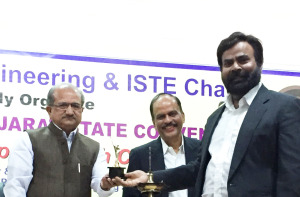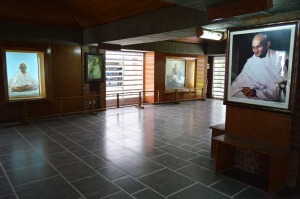[cycloneslider id=”india-day-4″]
Today the Chief Minister of the State Gujarat recognized the Haas School of Business in a Special ceremony. A special award was issued by the Minister of Education on behalf of the Chief Minister to welcome future collaboration from UC Berkeley. At this ceremony the Haas Students who visited the smart city were acknowledged personally by the minister. The students were called to the podium by the minister for a photo shoot and the award was presented to Professor Darwin to welcome future collaboration.
 Given a special award issued by the Minister of Education, we were honored to receive an award recognizing Haas’s involvement in the smart city dialogue with the Government of Gujarat, the home of the first smart city in India. With this award comes several potential partners that are interested in partnering with Haas to transform Bay Area cities at home, including the government, corporations, and field experts in sustainable technology in India. Partners will be the key to value creation in smart cities, and Haas students are excited to forge this partnership with our global counterparts. It is inspirational and humbling to see just how far the Haas Network has come and how our status as a top business school has given us recognition worldwide.
Given a special award issued by the Minister of Education, we were honored to receive an award recognizing Haas’s involvement in the smart city dialogue with the Government of Gujarat, the home of the first smart city in India. With this award comes several potential partners that are interested in partnering with Haas to transform Bay Area cities at home, including the government, corporations, and field experts in sustainable technology in India. Partners will be the key to value creation in smart cities, and Haas students are excited to forge this partnership with our global counterparts. It is inspirational and humbling to see just how far the Haas Network has come and how our status as a top business school has given us recognition worldwide.
With a day to reflect on our learnings thus far and immerse ourselves in the day-to-day of Ahmedabad city residents, we boarded a bus to visit the Gandhi Ashram and the Heritage Walk.
 Although Gandhi Ashram was a sacred hub of Gandhi’s wisdoms and journey, I was only able to truly appreciate his philosophy after observing the lifestyles and behaviors of Ahmedabad citizens through the Heritage Walk. After commuting in a tour bus for extended periods of time, only observing India’s streets and culture through a dusty glass window, it was refreshing to stroll down forgotten alleyways and narrow corridors where a large majority of city residents actually live—not the high-rise apartments and white-picket fences Americans are so familiar with. Our guide led us down cobblestone paths splattered with sewage water and residual rain, pointing out the intricate details in traditional Indian houses that used to shelter 60 people in a handful of rooms at a time and secret passageways that protected residents from crime outside. We also visited a bustling marketplace where small business owners stood outside hole-in-the-wall shops and pushed around carts and wagons full of food and accessories in hopes of drawing the attention of us foreigners walking by. Each of them was an entrepreneur by their own definition. Although living quarters were humble and sanitation was a privilege, it seemed as though every small alleyway bred a tight-knit community of neighbors who shared both pain and happiness with each other throughout the seasons. In the absence of the glitz and glamour of startup incubators and Silicon Valley aspirations, the poor must be the masterminds behind frugal innovations for everyday survival. I longed to be welcomed into one of their homes to see it for myself.
Although Gandhi Ashram was a sacred hub of Gandhi’s wisdoms and journey, I was only able to truly appreciate his philosophy after observing the lifestyles and behaviors of Ahmedabad citizens through the Heritage Walk. After commuting in a tour bus for extended periods of time, only observing India’s streets and culture through a dusty glass window, it was refreshing to stroll down forgotten alleyways and narrow corridors where a large majority of city residents actually live—not the high-rise apartments and white-picket fences Americans are so familiar with. Our guide led us down cobblestone paths splattered with sewage water and residual rain, pointing out the intricate details in traditional Indian houses that used to shelter 60 people in a handful of rooms at a time and secret passageways that protected residents from crime outside. We also visited a bustling marketplace where small business owners stood outside hole-in-the-wall shops and pushed around carts and wagons full of food and accessories in hopes of drawing the attention of us foreigners walking by. Each of them was an entrepreneur by their own definition. Although living quarters were humble and sanitation was a privilege, it seemed as though every small alleyway bred a tight-knit community of neighbors who shared both pain and happiness with each other throughout the seasons. In the absence of the glitz and glamour of startup incubators and Silicon Valley aspirations, the poor must be the masterminds behind frugal innovations for everyday survival. I longed to be welcomed into one of their homes to see it for myself.
By Christina Yu and Isabelle Lee
For additional information on the course UGAB 193i- Building Smart Cities Leveraging Open Innovation, visit the website here